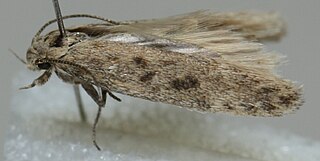
Sphenarches zanclistes is a moth of the family Pterophoridae that is found in Australia.

Sarisophora leucoscia is a moth in the family Lecithoceridae. It is found in Australia and New Zealand.

Scrobipalpa obsoletella, the summer groundling, is a moth of the family Gelechiidae. It is found in most of Europe, Turkey, the Caucasus, from Iran to Asian Russia (Transbaikal) and Mongolia. It has also been recorded from New Zealand, South Africa and North America, where it is probably an introduced species. The habitat consists of coastal salt marshes and sandy beaches.
Syllepte phaeopleura is a moth in the family Crambidae. It is found in Australia, where it has been recorded from Queensland.
Voliba psammoessa is a moth in the family Crambidae. It was described by Turner in 1908. It is found in Australia, where it has been recorded from Queensland.
Hoplomorpha caminodes is a moth in the family Oecophoridae. It was described by Alfred Jefferis Turner in 1916. It is found in Australia, where it has been recorded from Queensland.
Dichomeris zygophorus is a moth in the family Gelechiidae. It was described by Edward Meyrick in 1904. It is found in Australia, where it has been recorded from Queensland.
Hypatima euplecta is a species of moth in the family Gelechiidae. It was described by Edward Meyrick in 1904. It is found in Australia, where it has been recorded from Queensland, New South Wales, Victoria and South Australia.
Ardozyga thyrsoptera is a species of moth in the family Gelechiidae. It was described by Edward Meyrick in 1904. It is found in Australia, where it has been recorded from Queensland.
Ardozyga nothrodes is a species of moth in the family Gelechiidae. It was described by Edward Meyrick in 1921. It is found in Australia, where it has been recorded from southern Queensland.
Battaristis orthocampta is a moth of the family Gelechiidae. It was described by Edward Meyrick in 1914. It is found in Guyana.
Stenoma cana is a moth of the family Depressariidae. It is found in Brazil (Amazonas), Peru and French Guiana.
Antaeotricha heterosaris is a moth of the family Depressariidae. It is found in Guyana and French Guiana.
Stenoma iatma is a moth of the family Depressariidae. It is found in French Guiana.
Lethata satyropa is a moth of the family Depressariidae. It is found in French Guiana.
Antaeotricha cantharitis is a moth of the family Depressariidae. It is found in French Guiana.
Stenoma emphatica is a moth of the family Depressariidae. It is found in French Guiana.
Antiochtha vigilax is a moth in the family Lecithoceridae. It was described by Edward Meyrick in 1910. It is found in Sri Lanka.
Lecithocera compsophila is a moth in the family Lecithoceridae. It was described by Edward Meyrick in 1911. It is found in Sri Lanka.
Epithetica typhoscia is a moth in the family Depressariidae, and the only species in the genus Epithetica. It was described by Alfred Jefferis Turner in 1923 and is found in Australia, where it has been recorded from New South Wales.


